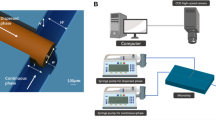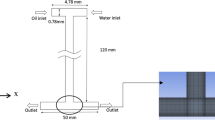Abstract
For further understanding the dispersion process in the T-shaped microfluidic device, a double-pore T-shaped microchannel was designed and tested with octane/water system to form monodispersed plugs and droplets in this work. The liquid–liquid two-phase flow patterns were investigated and it was found that only short plugs, relative length L/w < 1.4, were produced. Additionally, the droplets flow was realized at phase ratios (F C /F D) just higher than 0.5, which is much smaller than that in the single-pore T-shaped microchannels. A repulsed effect between the initial droplets was observed in the droplet formation process and the periodic fluctuation flow of the dispersed phase was discussed by analyzing the resistances. Besides, the effect of the two-phase flow rates on the plug length and the droplet diameter was investigated. Considering the mutual effect of the initial droplets and the equilibrium between the shearing force with the interfacial tension, phase ratio and Ca number were introduced into the semi-empirical models to present the plug and droplet sizes at different operating conditions.










Similar content being viewed by others
Abbreviations
- Ca :
-
Capillary number
- d :
-
droplet diameter (mm)
- d av :
-
average droplet size (mm)
- d p :
-
diameter of the pore (mm)
- d w :
-
initial droplets width (mm)
- F C :
-
continuous phase flow rate (μL/min)
- F D :
-
dispersed phase flow rate (μL/min)
- F P :
-
pressure between the initial droplets
- F S :
-
shearing force of the cross-flow
- L av :
-
average length of the plugs (mm)
- l p :
-
length of the pore (mm)
- P D :
-
pressure in the dispersed fluid inlet (Pa)
- P C :
-
pressure at the junction in the continuous fluid (Pa)
- R p,HP+S :
-
flow resistance (m−3)
- u C :
-
velocity of the cross flow (m/s)
- V D :
-
dispersed phase flow rate through a pore (μL/min)
- w :
-
width of the channel (mm)
- γ :
-
interface tension (N/m)
- ∆p f :
-
pressure difference caused by the flow resistance (Pa)
- ∆p i :
-
pressure impetus of the dispersed fluid (Pa)
- ∆p Y–L :
-
pressure difference caused by the interfacial tension (Pa)
- δ :
-
standard deviation of droplet size (mm)
- μ C :
-
viscosity of continuous phase (Pa s)
- μ D :
-
viscosity of the dispersed phase (Pa s)
- σ :
-
polydispersity index (%)
References
Anna SL, Bontoux N, Stoneb HA (2003) Formation of dispersions using “flow focusing” in microchannels. Appl Phys Lett 82:364–366
Chen Y, Wang YJ, Yang LM, Luo GS (2008) Micrometer-sized monodispersed silica spheres with advanced adsorption properties. AIChE J 54:298–309
Christopher GF, Anna SL (2007) Microfluidic methods for generating continuous droplet streams. J Phys D Appl Phys 40:R319–R336
Chu LY, Kim JW, Shah RK, Weitz DA (2007a) Monodisperse thermoresponsive microgels with tunable volume-phase transition kinetics. Adv Funct Mater 17:3499–3504
Chu LY, Utada AS, Shah RK, Kim JW, Weitz DA (2007b) Controllable monodisperse multiple emulsions. Angew Chem Int Ed 46:8970–8974
deMello AJ (2003) Control and detection of chemical reactions in microfluidic systems. Nature 42:394–402
Garstecki P, Fuerstman MJ, Stonec HA, Whitesides GM (2006) Formation of droplets and bubbles in a microfluidic T-junction—scaling and mechanism of break-up. Lab Chip 6:437–446
Geerken MJ, Lammertink RGH, Wessling M (2007) Interfacial aspects of water drop formation at micro-engineered orifices. J Colloid Interface Sci 312:460–469
Gong XC, Lu YC, **ang ZY, Zhang YN, Luo GS (2007) Preparation of uniform microcapsules with silicone oil as continuous phase in a micro-dispersion process. J Microencapsul 24:767–776
Günther A, Jensen KF (2006) Multiphase microfluidics: from flow characteristics to chemical and materials synthesis. Lab Chip 6:1487–1503
Joanicot M, Ajdari A (2005) Droplet control for microfluidics. Science 309:887–888
Kobayashi I, Mukataka S, Nakajima M (2004) Effect of slot aspect ratio on droplet formation from silicon straight-through microchannels. J Colloid Interface Sci 279:277–280
Kobayashi I, Mukataka S, Nakajima M (2005) Novel asymmetric through-hole array microfabricated on a silicon plate for formulating monodisperse emulsions. Langmuir 21:7629–7632
Kobayashi I, Nakajima M, Mukataka S (2003) Preparation characteristics of oil-in-water emulsions using differently charged surfactants in straight-through microchannel emulsification. Colloid Surf A Physicochem Eng Asp 229:33–41
Kralj GH, Schmidt MA, Jensen KF (2005) Surfactant-enhanced liquid–liquid extraction in microfluidic channels with inline electric-field enhanced coalescence. Lab Chip 5:531–535
Lambrich U, Schubert H (2005) Emulsification using microporous systems. J Membr Sci 257:76–84
Nisisako T, Torii T (2008) Microfluidic large-scale integration on a chip for mass production of monodisperse droplets and particles. Lab Chip 8:287–293
Nisisako T, Torii T, Higuchi T (2002) Droplet formation in a microchannel network. Lab Chip 2:24–26
Shui LL, Eijkel JCT, van den Berg A (2007) Multiphase flow in microfluidic systems–Control and applications of droplets and interfaces. Adv Colloid Interface Sci 133:35–49
Song H, Tice JD, Ismagilov RF (2003) A microfluidic system for controlling reaction networks in time. Angew Chem Int Ed 42:767–772
Song H, Chen DL, Ismagilov RF (2006) Reactions in droplets in microfluidic channels. Angew Chem Int Ed 45:7336–7356
Sugiura S, Nakajima M, Kumazawa N, Iwamoto S, Seki M (2002a) Characterization of spontaneous transformation-based droplet formation during microchannel emulsification. J Phys Chem B 106:9405–9409
Sugiura S, Nakajima M, Seki M (2002b) Prediction of droplet diameter for microchannel emulsification. Langmuir 18:3854–3859
Tan J, Xu JH, Li SW, Luo GS (2008) Drop dispenser in a cross-junction microfluidic device: scaling and mechanism of break-up. Chem Eng J 136:306–311
Tice JD, Lyon AD, Ismagilov RF (2004) Effects of viscosity on droplet formation and mixing in microfluidic channels. Anal Chim Acta 507:73–77
van der Graaf S, Steegmans MLJ, van der Sman RGM, Schröen CGPH, Boom RM (2005) Droplet formation in a T-shaped microchannel junction: a model system for membrane emulsification. Colloid Surf A Physicochem Eng Asp 266:106–116
Wang WH, Zhang ZL, **e YN, Wang L, Yi S, Liu K, Liu J, Pang DW, Zhao XZ (2007) Flow-focusing generation of monodisperse water droplets wrapped by ionic liquid on microfluidic chips: from plug to sphere. Langmuir 23:11924–11931
Xu JH, Li SW, Tan J, Wang YJ, Luo GS (2006a) Preparation of highly monodisperse droplet in a t-junction microfluidic device. AIChE J 52:3005–3010
Xu JH, Li SW, Tan J, Wang YJ, Luo GS, Chen GG (2006b) Controllable preparation of monodisperse O/W and W/O emulsions in the same microfluidic device. Langmuir 22:7943–7946
Xu JH, Luo GS, Li SW, Chen GG (2006c) Shear force induced monodisperse droplet formation in a microfluidic device by controlling wetting properties. Lab Chip 6:131–136
Xu QY, Nakajima M (2004) The generation of highly monodisperse droplets through the breakup of hydrodynamically focused microthread in a microfluidic device. Appl Phys Lett 85:3726–3728
Zheng B, Tice JD, Ismagilov RF (2004) Formation of droplets of alternating composition in microfluidic channels and applications to indexing of concentrations in droplet-based assays. Anal Chem 76:977–4982
Acknowledgments
We gratefully acknowledge the supports of the National Natural Science Foundation of China (20490200, 20525622) and National Basic Research Program of China (2007CB714302) on this work.
Author information
Authors and Affiliations
Corresponding author
Rights and permissions
About this article
Cite this article
Wang, K., Lu, Y.C., Xu, J.H. et al. Liquid–liquid micro-dispersion in a double-pore T-shaped microfluidic device. Microfluid Nanofluid 6, 557–564 (2009). https://doi.org/10.1007/s10404-008-0332-2
Received:
Accepted:
Published:
Issue Date:
DOI: https://doi.org/10.1007/s10404-008-0332-2




